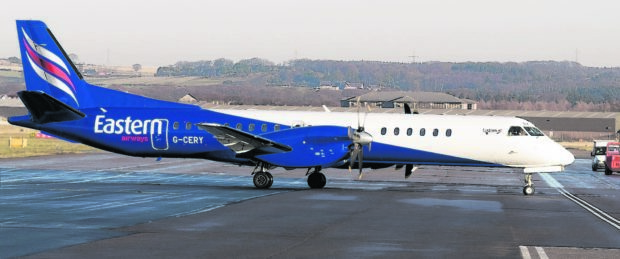A passenger plane heading for Stornoway was forced to plunge 800ft in a near miss with an RAF jet over Moray.
The captain of the Eastern Airways service, which had taken off from Aberdeen Airport, took evasive action when a Typhoon descended too far after its pilot became “temporarily distracted”.
Yesterday, an official report revealed the planes passed within about 500ft of each other as the jet returned to RAF Lossiemouth from a training exercise.
An investigation by the UK Airprox Board put the category of risk for the August 25 incident at “B” – the second highest, which means “safety not assured”.
Up to 50 passengers could have been on board the Saab 2000 aircraft, which was being operated by Eastern Airways.
The Airprox report describes how the commercial pilots were made aware of the four air force planes when they entered an area about 17 miles south of Lossiemouth.
Initially the Eastern Airways crew saw two of the aircraft descend below the expected level, which made them pay “closer attention” to the remaining two.
A short time later the captain saw the Typhoons carrying out a turn before his traffic collision avoidance system (TCAS) alerted him and he immediately descended 800ft.
The pilot reported that he believed one of the jets had also taken “avoiding action”.
Investigators concluded that “in-cockpit activity” had contributed to the RAF fighter descending further than expected, which was corrected after 10 seconds.
The RAF’s Air Command told the Airprox board: “The tactical portion of the sortie was complete and the aircraft were recovering to base, a seemingly much more ‘straightforward’ element of the sortie.
“It seems likely that the pilot identified this as an appropriate time to prepare for recovery and, by his own admission, allowed the aircraft altitude to drop out of his scan.
“It is often during the most seemingly benign tasks that are common to all sorties – such as recovery to home base – that distraction is most likely to become a factor.”
The pilot of the Typhoon considered the severity of the incident to be “low”.
A spokeswoman for Eastern Airways confirmed a service flying from Aberdeen to Stornoway was involved in the incident.
She added: “The pilots were receiving a service from Scottish Air Traffic Control and were made aware of two fast moving jets in the vicinity above their flight level.
“The Saab captain reacted to the aircraft’s TCAS alert to descend immediately, which he did so to maintain safe separation from one of the two military jets.
“Our crews were operation in accordance with air traffic control and company procedures.”
